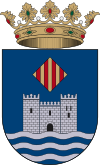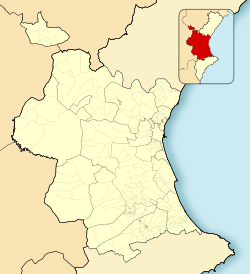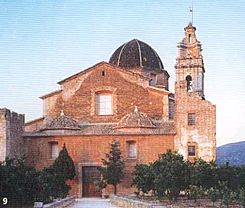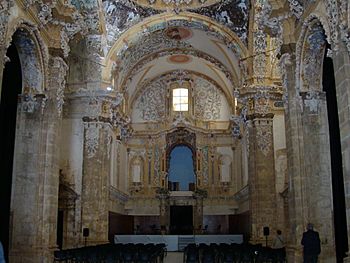Simat de la Valldigna facts for kids
Quick facts for kids
Simat de la Valldigna
|
||
|---|---|---|
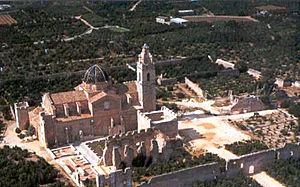 |
||
|
||
| Country | ||
| Autonomous community | ||
| Province | Valencia | |
| Comarca | La Safor | |
| Judicial district | Sueca | |
| Area | ||
| • Total | 38.5 km2 (14.9 sq mi) | |
| Elevation | 45 m (148 ft) | |
| Population
(2018)
|
||
| • Total | 3,325 | |
| • Density | 86.36/km2 (223.7/sq mi) | |
| Demonym(s) | Simater, simatera | |
| Time zone | UTC+1 (CET) | |
| • Summer (DST) | UTC+2 (CEST) | |
| Postal code |
46750
|
|
| Official language(s) | Valencian | |
Simat de la Valldigna is a small town, also called a municipality, in the Valencian Community of Spain. It's part of a region known as La Safor. The town is about 50 kilometers (31 miles) from the big city of Valencia. It's also close to other towns like Cullera, Gandia, Xàtiva, and Alzira.
Simat de la Valldigna is one of four villages in a beautiful natural area called La Valldigna. This valley is surrounded by mountains. To the north, you'll find the Serra de Corbera mountains. To the south, there's the Montdúver mountain. And to the east, the Mediterranean Sea is not far away.
Contents
Exploring Simat de la Valldigna
Getting There
If you're coming from Valencia, you can reach Simat de la Valldigna by car. You'll take a few different roads, like the V-31, CV-42, CV-50, and finally the CV-600. It's a straightforward drive to this lovely valley.
Small Villages Nearby
Within the municipality of Simat de la Valldigna, there are two smaller communities. These are called Pla de Corrals and Les Foies.
Neighboring Towns
Simat de la Valldigna shares its borders with several other towns. These include Benifairó de la Valldigna, Xeresa, Barx, Quatretonda, Barxeta, Carcaixent, and Pinet. All these towns are located in the Province of Valencia.
Weather in Simat
Simat de la Valldigna enjoys a very pleasant climate. Because it's nestled in a valley and protected by mountains, the weather is mild. Summers are warm, and winters are not too cold. Simat is also known for getting a good amount of rain, especially compared to other parts of the Valencian Country.
A Look Back in Time
People have lived in the area around Simat de la Valldigna for a very long time. Evidence of early human life has been found in nearby caves. However, the first clear historical records come from the time when Muslims lived here.
A big change happened in the 13th century when Christian kings started to conquer these lands. King James I took control, and later his grandson, James II, gave the land to a group of monks called the Cistercian order.
The story goes that King James II was returning from a trip and passed through this valley. He was so amazed by its beauty that he said, "Vall digna per a un monestir de la vostra religió!" This means "A suitable valley for a monastery of your order!" The abbot (leader) of the Santes Creus monastery replied, "Vall digna!" (Suitable valley!).
So, on March 15, 1297, King James II gave this valley to the Cistercian monks. They were to build a monastery dedicated to the Virgin Mary. From that moment on, the valley's name changed from Alfàndec to Valldigna, meaning "worthy valley."
For a while, Christians and Muslims lived together in Valldigna. Muslims were allowed to keep their faith. They would gather at the La Xara mosque to pray and learn. However, this peaceful coexistence ended in 1609. At that time, all people of Moorish (Muslim) descent were forced to leave Spain.
Life in the valley continued under the rule of the monastery until 1835. This was when the Spanish government took control of all monasteries in Spain. The monastery in Simat became private property until 1991. Then, the regional government of Valencia bought it to protect and restore it.
Culture and Heritage
The most important building in Simat de la Valldigna is the Monastery of Santa María de la Valldigna. It was founded in 1297 by James II. This monastery became one of the most important for the Cistercian monks.
The monks lived there until 1835. After a local uprising, they had to leave. Many of the monastery's treasures were sold or destroyed. For many years, the monastery was left to fall apart. But now, many projects are underway to restore it.
Today, the Monastery of Santa Maria de Valldigna is seen as a very important place for the history and culture of the Valencian Community. The regional government is working to bring it back to its former glory. They want it to be a meeting place for all Valencians and a center for studying the region's history.
Simat de la Valldigna was also the first town in the Valencian Country to ask for a .cat internet domain for its town hall website. This shows their connection to their language and culture.
Important Buildings and Places
- Monastery of Santa María de la Valldigna: This is the most impressive building in the valley. It was an old Cistercian monastery that was once in ruins. Now, the Valencian government is working hard to restore it.
- La Xara Mosque or Saint Anne Hermitage: This small building is in the middle of orange groves. It's the only building left from an old village called la Xara, which was abandoned in 1609. This building used to be a mosque. It has a rectangular shape and a special arch at the entrance. Inside, you can still see the Qibla, which shows the direction of Mecca for prayers. There's also an old well outside where people would wash before praying.
- Saint Michael Archangel Church: This is the main church in the town today. It's built in a baroque style, and the statue of Saint Michael inside is quite interesting.
- Font Gran (Big Fountain): This natural fountain is located in the town square that shares its name. It has a large pool of water and is a pleasant spot in the village.
How Simat Makes a Living
Farming is the main way people in Simat de la Valldigna earn money. They mostly grow oranges and other citrus fruits. To sell these fruits, there are two cooperatives where many local people work.
In recent years, the government has tried to make the Monastery of Santa Maria de Valldigna a popular place for tourists. While it's a beautiful site, not many visitors come yet.
Fun Festivities
Simat de la Valldigna is well-known for its many celebrations throughout the year!
- Saint Anthony: On January 16, the night before Saint Anthony's Day, everyone gathers in the Town Hall square. They light a huge bonfire! Afterward, people visit certain homes where they get to enjoy fritters and wine. The night ends with an outdoor dance. On Saint Anthony's Day itself, there's a special mass where animals, bread, and traditional cakes are blessed.
- Valldigna Day: On March 15, all the people from the Valldigna valley (including those from Barx, Benifairó de la Valldigna, Simat, and Tavernes de la Valldigna) celebrate the founding of the Cistercian monastery. There's a fun medieval fair and another outdoor dance.
- Saint James and Saint Anne: These festivities are celebrated on July 25 and 26.
- Saint Patrons' Festivities: Simat celebrates its main saint patrons, Abdon and Sennen, on August 4, 5, and 6.
- October 9 "National Day of the Valencian Country": This day is a big celebration! There's often a contest to make paella, a famous Valencian dish. You'll also hear traditional Valencian street bands playing the dolçaina, a special instrument. In the evening, there's an outdoor dance and the exciting traditional correfoc (fire run).
Famous People from Simat
- Francisco Luis Brines Ferrer, known as Coeter II, a famous Valencian pilota player.
- Miquel Brines Ferrer, known as Coeter I, also a Valencian pilota player.
- Lluís Brines Selfa, a professional musician who played in the Municipal Band of Barcelona and the Gran Teatre del Liceu in Barcelona.
- Luis Francisco Cucarella Mas, known as Loripet, another Valencian pilota player.
- Terenci Miñana i Andrés, known as el xiquet de Simat, a Valencian pilota player.
Images for kids
See also
 In Spanish: Simat de Valldigna para niños
In Spanish: Simat de Valldigna para niños


